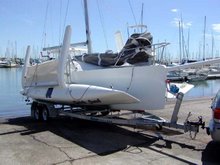
Hi there a note from the no-workspace-at-all department.
 I fitted the ancherwell floor in place before fitting the starboard side of the forward bulkhead. This mean that I was able to tape both the bottom and top of the plate in the watertight compartment. Plan origanally is to fit this floor from the top through the ancher hatch; so no proper taping of the bottom of the floor is possible. I had to fit the bulkhead after this difficult task was accomplished, and tape the bottom part of the bulkhead using a mirror to see that I was doing OK. I was taping through a 15 cm hole for a inspectionhatch. Below a shot from inside the watertight compartment that show the tape is fitted well. When I later do the ancherhatch I can do the remaining taping to floor and bulkhead.
I fitted the ancherwell floor in place before fitting the starboard side of the forward bulkhead. This mean that I was able to tape both the bottom and top of the plate in the watertight compartment. Plan origanally is to fit this floor from the top through the ancher hatch; so no proper taping of the bottom of the floor is possible. I had to fit the bulkhead after this difficult task was accomplished, and tape the bottom part of the bulkhead using a mirror to see that I was doing OK. I was taping through a 15 cm hole for a inspectionhatch. Below a shot from inside the watertight compartment that show the tape is fitted well. When I later do the ancherhatch I can do the remaining taping to floor and bulkhead.  When taping difficult-to-reach-places, a good method is: apply a coat of resin to the joining pieces with a brush after the bog fillet is done. Wet out tape properly using brush, air roll and scraper on a table or piece of ply covered with plastic so no air is visible. Place tape over join, you can use a stick or spartel or whatever the situ calls for use imagination, use (long) brush/ cloved hand to remove air, maybe the alu roll, and last use peelply to make it stick and to make a surface that is almost ready for paint/filler. I even did upsidedown taping in the watertight compartment using two pieces instaed of one, makes it easier than one long that tends to fall down before you reach the far end. Giving a good coat of resin to the surface is an absolut must, dont be affraid to spend 25 g of resin on this.
When taping difficult-to-reach-places, a good method is: apply a coat of resin to the joining pieces with a brush after the bog fillet is done. Wet out tape properly using brush, air roll and scraper on a table or piece of ply covered with plastic so no air is visible. Place tape over join, you can use a stick or spartel or whatever the situ calls for use imagination, use (long) brush/ cloved hand to remove air, maybe the alu roll, and last use peelply to make it stick and to make a surface that is almost ready for paint/filler. I even did upsidedown taping in the watertight compartment using two pieces instaed of one, makes it easier than one long that tends to fall down before you reach the far end. Giving a good coat of resin to the surface is an absolut must, dont be affraid to spend 25 g of resin on this.  Also did some taping of deck and case with layers of unicarbon.
Also did some taping of deck and case with layers of unicarbon.













7 comments:
Hello Martin. I have a question regarding foam leaks during vacuum bagging. How do you attack these?
That is a problem that only can be solved by bogging the seams very carefully and stil you can have a miss. Then when the vacuumbag is pulled your only chance to get it right is from the outside. I find the leak and try to seal it with tacky tape or a regular sealant. Maybe it is behind a stringer and you must cutout a bit to get access. I know it is most frustratin but that how it is. Trick is to use a very slow hardener so you will not get stressed because the epoxy starts curing. If a pressure of -0.7 - -0.9 bar is in reach dont worry, that is good enough for a desent vacuum to get a tight laminate. Wet out proberly and make it as good as you can, like you had no vaccum at all. Or you could do infusion and solve all problems before infusing any resin, no stress at all, but it takes longer to set up, and you need a special epoxy for this as well as a ordenary for hand laminating.
Bogging should be done with a not to thick bog so it will stick well to the foam, and do it in two sessions. Also I find that wetting the foam before appling the laminate will make a better bond to the foam than the dry layup, you could end up making a to dry laminate with to little resin between foam and laminate. If using SP system epoxy read the manual regarding earliest(latest) time to pull the vacuum. If using an extra slow hardener it is several hours or you could drain laminate ending up with too much resin in the bleeder material. Do some test on a flat table before doing the hulls.
Fell free to ask if in doubt.
Thanks for all the info. I'm trying to get a steep learning curve. As often the devil is in the details.
Do you wet out the foam just before applying the glass? Or do you apply the glass when the first layer of epoxy has partly cured?
No, you just wait maybe 5 min to let the foam soak a bit, not a heavy layer just enough to wet the foam. Then apply glass, this is more difficult than dry layup since it is harder to possition the glass proberly, you need to lift it to rearrange it. But it will soak up any epoxy from the wet foam and you just fill up the weave and lighty scrape with a plastic scraper, as seen in some of my older post. If to much epoxy is present just move it to a dry spot. You will notice the right amount once you try it a couple of times. Also you could weight the glass and then you should be using about the same amount epoxy. That will give a ratio about 60% glass and 40% since the peelply and bleeder will soak a bit. You can make a flat panel and measure the weight of foam, glass and epoxy used, and compare the complete weight, when it has cured and the bleeder and peelply is removed.
that is 60 % glass and 40 % epoxy.
Hi again Nico
You should read this, lots of info on the subject. http://www.fram.nl/workshop/controlled_vacuum_infusion/cvi.htm
Thanks again. I will try to put it all in praxis.
Nico
Post a Comment